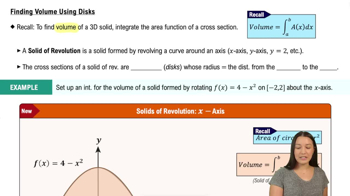Find the volume of the solid obtained by rotating the region bounded by , , & about the x-axis.
Table of contents
- 0. Functions7h 54m
- Introduction to Functions16m
- Piecewise Functions10m
- Properties of Functions9m
- Common Functions1h 8m
- Transformations5m
- Combining Functions27m
- Exponent rules32m
- Exponential Functions28m
- Logarithmic Functions24m
- Properties of Logarithms36m
- Exponential & Logarithmic Equations35m
- Introduction to Trigonometric Functions38m
- Graphs of Trigonometric Functions44m
- Trigonometric Identities47m
- Inverse Trigonometric Functions48m
- 1. Limits and Continuity2h 2m
- 2. Intro to Derivatives1h 33m
- 3. Techniques of Differentiation3h 18m
- 4. Applications of Derivatives2h 38m
- 5. Graphical Applications of Derivatives6h 2m
- 6. Derivatives of Inverse, Exponential, & Logarithmic Functions2h 37m
- 7. Antiderivatives & Indefinite Integrals1h 26m
- 8. Definite Integrals4h 44m
- 9. Graphical Applications of Integrals2h 27m
- 10. Physics Applications of Integrals 3h 16m
- 11. Integrals of Inverse, Exponential, & Logarithmic Functions2h 34m
- 12. Techniques of Integration7h 41m
- 13. Intro to Differential Equations2h 55m
- 14. Sequences & Series5h 36m
- 15. Power Series2h 19m
- 16. Parametric Equations & Polar Coordinates7h 58m
9. Graphical Applications of Integrals
Introduction to Volume & Disk Method
Problem 8.3.65
Textbook Question
65. Volume Find the volume of the solid generated when the region bounded by y = sin²(x) * cos^(3/2)(x) and the x-axis on the interval [0, π/2] is revolved about the x-axis.
 Verified step by step guidance
Verified step by step guidance1
Step 1: Recognize that the problem involves finding the volume of a solid of revolution. The formula for the volume when a region is revolved about the x-axis is given by: , where f(x) is the function describing the region and [a, b] is the interval of integration.
Step 2: Identify the function and interval from the problem. Here, the function is , and the interval is . Substitute these into the volume formula.
Step 3: Set up the integral for the volume. The integral becomes: . Simplify the integrand by squaring the function: .
Step 4: Rewrite the integral with the simplified integrand: . To solve this integral, consider using trigonometric identities or substitution methods. For example, you might use the identity to simplify further.
Step 5: Apply appropriate integration techniques, such as substitution or reduction formulas, to evaluate the integral. Once the integral is solved, multiply the result by π to find the volume. Ensure all steps are carefully followed to handle the trigonometric powers correctly.
 Verified video answer for a similar problem:
Verified video answer for a similar problem:This video solution was recommended by our tutors as helpful for the problem above
Video duration:
2mPlay a video:
Was this helpful?
Key Concepts
Here are the essential concepts you must grasp in order to answer the question correctly.
Volume of Revolution
The volume of revolution refers to the volume of a solid formed by rotating a two-dimensional shape around an axis. In calculus, this is typically calculated using methods such as the disk method or the washer method, which involve integrating the area of circular cross-sections perpendicular to the axis of rotation.
Recommended video:

Finding Volume Using Disks
Definite Integral
A definite integral calculates the accumulation of quantities, such as area or volume, over a specific interval. In this context, it is used to find the volume of the solid generated by revolving the given function around the x-axis, integrating from the lower to the upper bounds of the interval, [0, π/2].
Recommended video:

Definition of the Definite Integral
Trigonometric Functions
Trigonometric functions, such as sine and cosine, are fundamental in calculus, especially when dealing with periodic phenomena. The function y = sin²(x) * cos^(3/2)(x) combines these functions, and understanding their behavior and properties is essential for evaluating the integral and determining the volume of the solid formed.
Recommended video:

Introduction to Trigonometric Functions

 5:38m
5:38mWatch next
Master Introduction to Cross Sections with a bite sized video explanation from Patrick
Start learningRelated Videos
Related Practice
Multiple Choice
120
views
3
rank
